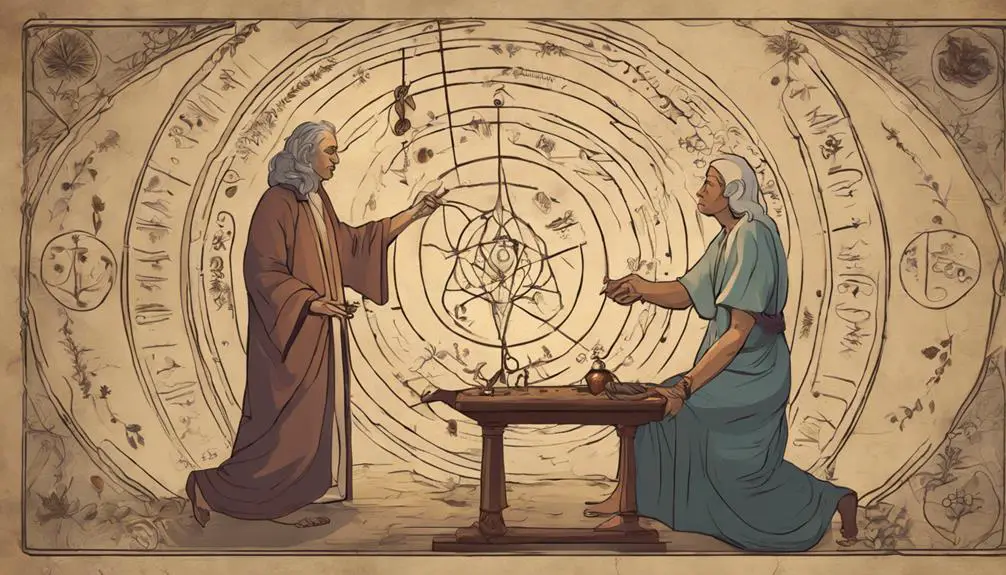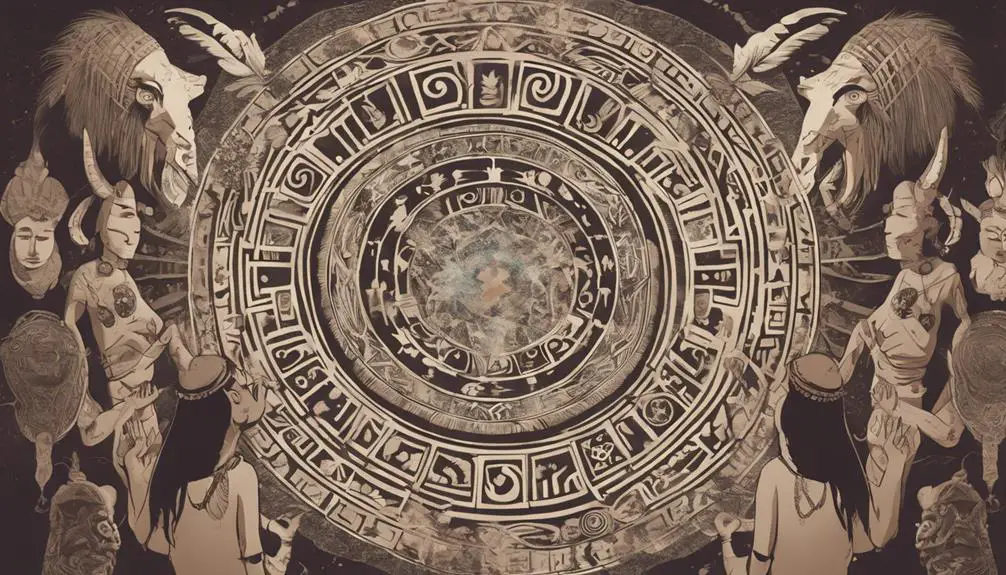Origins of Hypnosis Timeline
Why Did Ancient Civilizations Use Hypnosis Traditionally?
February 4, 2018 - Origins of Hypnosis Timeline
Ancient civilizations like Egypt and Greece employed hypnosis for healing, spiritual purposes, and unlocking hidden knowledge. Hypnotic techniques were integrated into rituals, aiding in spiritual connections and guiding healing practices. Shamans and healers utilized induced trance-like states to communicate with the spiritual realm or subconscious mind. Hypnosis in sleep temples and shamanic practices emphasized a holistic approach to well-being. Techniques like chanting, music, and visualization were used to address physical and mental well-being. This traditional use of hypnosis played a significant role in early civilizations for promoting healing and spiritual growth.
Early Evidence of Hypnosis Practices

The early evidence of hypnosis practices in ancient civilizations provides insight into the historical significance of this therapeutic technique and its traditional use across cultures.
Ancient techniques of hypnosis can be traced back to the Egyptian and Greek civilizations, where healers and priests utilized hypnotic practices for various purposes. In ancient Egypt, a form of sleep temple therapy involved inducing a trance-like state to treat physical and psychological ailments, showcasing the traditional use of hypnosis for healing.
Furthermore, in ancient Greece, the practice of temple sleep was prevalent, where individuals would seek guidance or healing through dreams induced by hypnotic techniques. These instances highlight the historical significance of hypnosis as a tool for spiritual and therapeutic purposes in early civilizations.
The varied applications of hypnosis across different cultures reflect its enduring presence and adaptability throughout history. By examining the ancient roots of hypnosis practices, we can appreciate the evolution of this technique and its continued relevance in modern therapeutic settings.
Spiritual and Healing Purposes
Historically, hypnosis has been utilized for spiritual and healing purposes across various ancient civilizations, demonstrating its enduring role in addressing psychological and physical ailments through trance-like states.
In these civilizations, hypnosis was often intertwined with meditation practices to induce altered states of consciousness that were believed to facilitate spiritual connection and healing.
For instance, in ancient Egypt, priests used hypnotic techniques during healing rituals to invoke a trance-like state in patients, guiding them to connect with spiritual energies for restoration.
Similarly, in ancient Greece, hypnosis was employed by healers like Asclepius in sleep temples to induce dreams that were interpreted as messages from the divine, guiding individuals towards healing and self-discovery.
These practices highlight the deep-rooted belief in the power of hypnosis to not only address physical ailments but also to foster a profound spiritual connection, emphasizing the holistic approach to healing prevalent in ancient civilizations.
Role of Hypnosis in Rituals

Various ancient civilizations integrated hypnosis into their rituals, harnessing the power of trance-like states for spiritual and healing purposes. The role of hypnosis in rituals was of significant importance due to its ritual significance in inducing altered states of consciousness.
Cultural ceremonies often involved hypnotic induction techniques to guide participants into deep trance states where they could access spiritual realms, receive divine messages, or undergo healing processes. These rituals were meticulously designed to induce a profound sense of connection with the divine or spiritual entities, promoting healing and personal transformation.
The use of hypnosis in rituals served as a bridge between the physical and spiritual worlds, allowing individuals to explore inner landscapes and tap into subconscious resources for personal growth and healing. The intricate weaving of hypnosis into cultural ceremonies highlights the deep-rooted belief in the power of altered states of consciousness to facilitate spiritual experiences and bring about profound changes in individuals within ancient civilizations.
Hypnosis in Shamanic Practices
Numerous archaeological findings suggest that hypnosis played a crucial role in the shamanic practices of ancient civilizations, providing insights into the profound impact of trance states on spiritual experiences and healing rituals.
Shamanic trance was a common practice among ancient shamans, who utilized altered states of consciousness induced through rhythmic chanting, dancing, and repetitive movements to communicate with the spirit world. Within these trance states, individuals were believed to be more receptive to healing energies and spiritual guidance.
Hypnotic healing, a phenomenon observed in shamanic practices, involved the shaman guiding individuals into a deep state of relaxation and focus, allowing them to access their subconscious mind and address underlying issues causing physical or emotional ailments. Through the use of suggestive language, visualization techniques, and energy manipulation, shamans facilitated the healing process by helping individuals release negative energies, restore balance, and promote overall well-being.
Hypnotic Techniques in Ancient Healing

Ancient civilizations employed a variety of hypnotic techniques in their healing practices, demonstrating a sophisticated understanding of the mind-body connection and the power of altered states of consciousness in promoting well-being.
These hypnotic techniques often involved inducing a hypnotic trance, a state of focused attention and heightened suggestibility. In ancient healing traditions, such as those of the Egyptians, Greeks, and Chinese, hypnotic trance was utilized to address various physical and mental health issues.
Within these civilizations, healers would guide individuals into a hypnotic state through techniques like rhythmic chanting, music, visualization, and storytelling. Once in this altered state of consciousness, the healer could suggest therapeutic benefits such as pain relief, emotional catharsis, or spiritual healing.
The use of hypnotic techniques in ancient healing highlights the belief in the interconnectedness of the mind and body, acknowledging that mental processes can significantly impact physical well-being. By harnessing the power of hypnotic trance, ancient civilizations were able to offer holistic healing approaches that addressed both the physical and psychological aspects of health.
Hypnosis for Altered States of Consciousness
Hypnosis serves as a powerful tool for inducing altered states of consciousness, allowing individuals to access heightened suggestibility and focused attention beyond their ordinary waking state. Trance states induced through hypnosis have been utilized for spiritual growth and self-exploration in various ancient traditions. These altered states of consciousness can provide individuals with a deeper connection to their inner selves, facilitating personal insight and transformative experiences.
In ancient civilizations, hypnosis was often employed as a means to enter altered states of consciousness for spiritual practices and healing rituals. Through the induction of trance states, individuals could tap into their subconscious minds, accessing hidden thoughts, emotions, and memories that may not be readily available in their waking state. This ability to transcend normal consciousness was valued for its potential to promote self-discovery, emotional release, and inner healing.
Furthermore, the use of hypnosis for altered states of consciousness in ancient traditions highlights the enduring interest in exploring the depths of the human mind and soul, demonstrating a timeless fascination with unlocking the mysteries of consciousness.
Cultural Beliefs and Hypnotic Influence

Cultural beliefs play a significant role in shaping the perception of hypnotic influence and its efficacy within societies worldwide. Throughout history, various cultural traditions have integrated hypnosis for its subconscious influence on individuals.
Indigenous practices often incorporated hypnotic techniques as a means to access altered states of consciousness, highlighting the historical significance of hypnosis in these communities. In many ancient civilizations, hypnosis was deeply intertwined with cultural rituals and spiritual practices.
Shamans and healers utilized hypnotic methods to induce trance-like states, believed to facilitate communication with the spiritual realm or the subconscious mind. These practices were rooted in the cultural belief that hypnosis could unlock hidden knowledge, promote healing, or resolve psychological issues. The enduring presence of hypnosis in cultural traditions underscores its enduring legacy and the continued relevance of hypnotic influence in diverse societies.
Frequently Asked Questions
How Did Ancient Civilizations View the Concept of Consciousness?
Ancient civilizations perceived consciousness as interconnected through a collective consciousness, believing in a shared spiritual awakening that transcended individual experiences. This view shaped their cultural practices, rituals, and understanding of the universe.
Were There Any Negative Consequences Associated With Ancient Hypnosis Practices?
Ancient hypnosis practices were embedded in societal norms and cultural beliefs. However, ethical concerns arose due to potential long-term effects on individuals. Negative consequences included loss of autonomy, psychological distress, and susceptibility to manipulation.
What Materials or Tools Were Used in Ancient Hypnotic Rituals?
Ancient tools and materials utilized in hypnotic rituals varied across civilizations. Examples include herbs, crystals, rhythmic sounds, and repetitive movements. These ritualistic practices aimed to induce altered states of consciousness, facilitating healing, spiritual connection, and personal growth.
How Did Ancient Civilizations Pass Down Hypnosis Techniques Through Generations?
Ancient civilizations passed down hypnosis techniques through cultural transmission, ensuring generational knowledge preservation. Historical hypnosis relied on oral traditions, hieroglyphics, and symbolic rituals to transmit ancient techniques. This method facilitated the continuity of hypnotic practices across centuries.
Did Different Ancient Cultures Have Variations in Their Approach to Hypnosis?
Cultural differences in ancient civilizations influenced variations in hypnotic techniques. Each culture tailored methods to suit their beliefs and practices, shaping unique approaches to induce trance states. These diverse traditions contributed to the rich tapestry of historical hypnosis practices.
Conclusion
In conclusion, ancient civilizations utilized hypnosis for spiritual and healing purposes, incorporating hypnotic techniques in rituals and shamanic practices.
The cultural beliefs of these societies played a significant role in the use of hypnosis for inducing altered states of consciousness.
The evidence suggests that hypnosis was deeply ingrained in traditional practices, serving as a tool for influencing and manipulating the mind in various cultural contexts.
